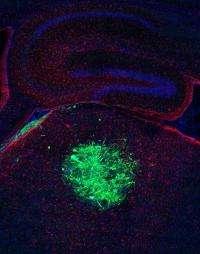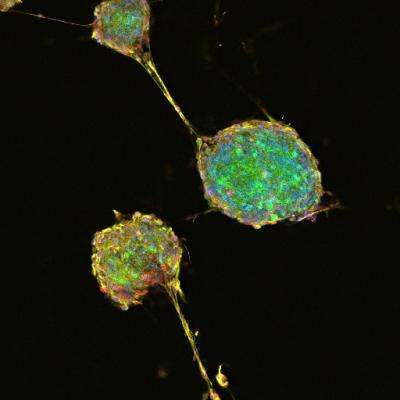October 19, 2012 report
New study finds brain tumors can arise from neurons

(Medical Xpress)—Researchers from the US and Japan have shown that an aggressive type of brain tumor can arise from normal cells in the central nervous system such as neurons. The cells revert to an earlier, undifferentiated stem cell stage, which can then reproduce prolifically.
The international team of scientists, led by Professor Inder Verma and geneticist Dr Dinorah Friedmann Morvinski, both of the Salk Institute for Biological Studies at La Jolla in California, studied the development of malignant glioblastoma tumors in mice. They had earlier developed a new method of researching cancer by using viruses to introduce cancer-causing genes (oncogenes) into the mice brains, as reported in Phys.Org.
Many of the mouse studies on cancer revolve around transplanting human tissue or cancer cells into immune-compromised mice to begin the process of tumor formation, but this is not the way that real tumors develop in humans. The San Diego team therefore designed a new method, which aimed to imitate the appearance of random mutations by transferring novel oncogenes to healthy mouse cells via genetically modified viruses.
In the new study, they also introduced oncogenes via viruses, and when tumors began to form they then transferred some of the cells to the brains of healthy mice. They discovered that only as few as 10 cells were needed to produce a tumor in the healthy brain.

Scientists had earlier assumed glioblastoma tumors only arose from glial cells, which support and protect the neurons and supply them with nutrients and oxygen. When stem cells were discovered within the brain, they were also implicated as being capable of leading to cancer cells.
The new research shows that tumors can in fact have their origins in several types of differentiated cells in the central nervous system, including neural stem cells, astrocytes (a sub-type of glial cell) and even neurons, when cancer-causing genes are introduced. Neurons do not divide, but when the genes were introduced they were found to transform into stem cells that could reproduce rapidly.
Tumors arising from astrocytes and neurons were similar to the most common and aggressive glioblastoma multiforme (GBM) brain tumors found in humans. The average length of survival after diagnosis of this type of tumor is around 14 months.
The research, reported in the journal Science, could explain why GBM tumors are so aggressive and difficult to treat, and why they can re-grow even after the tumor has been surgically removed or killed by chemotherapy drugs. In effect every cell left behind after the treatment can start the tumor-building process again.
The next phase of the research will be to learn more about the dedifferentiation process in which cells turn into reproducing stem cells, and then work out a way to block it.
More information: Dedifferentiation of Neurons and Astrocytes by Oncogenes Can Induce Gliomas in Mice, Science, DOI: 10.1126/science.1226929
ABSTRACT
Glioblastoma multiforme (GBM) is the most common and aggressive malignant primary brain tumor in humans. Here, we show that gliomas can originate from differentiated cells in the central nervous system (CNS), including cortical neurons. Transduction by oncogenic lentiviral vectors of neural stem cells (NSCs), astrocytes, or even mature neurons in the brain of mice can give rise to malignant gliomas. All the tumors, irrespective of the site of injection (initiating population), share common features of high expression of stem or progenitor markers and low expression of differentiation markers. Microarray analysis revealed that tumors of astrocytic and neuronal origin match the mesenchymal GBM subtype. We propose that most differentiated cells in the CNS upon defined genetic alterations undergo dedifferentiation to generate a NSC or progenitor state to initiate and maintain the tumor progression, as well as to give rise to the heterogeneous populations observed in malignant gliomas.
© 2012 Medical Xpress















